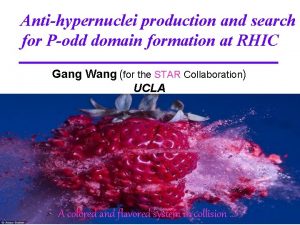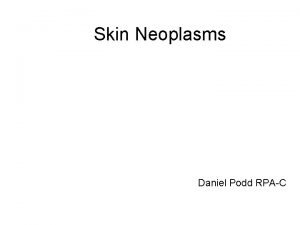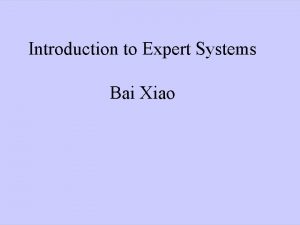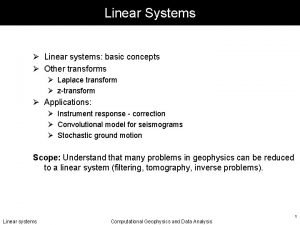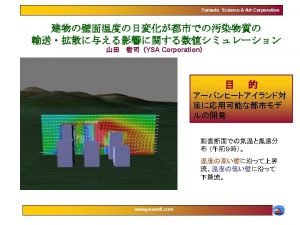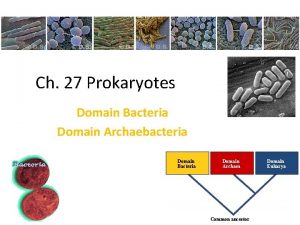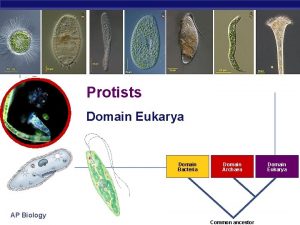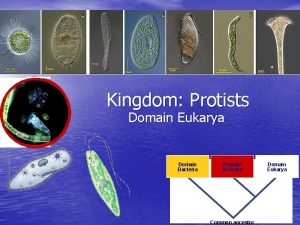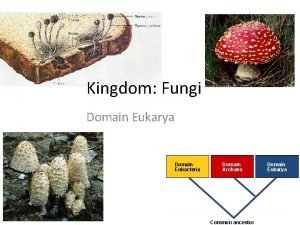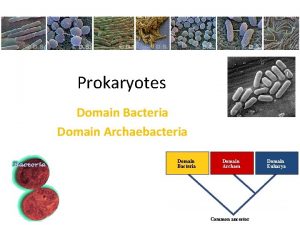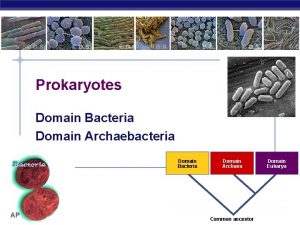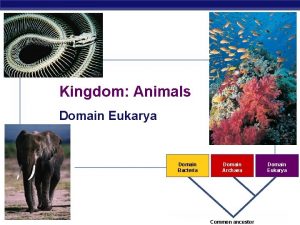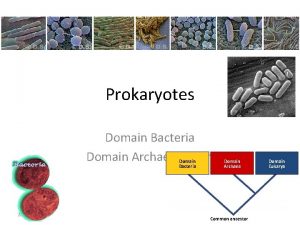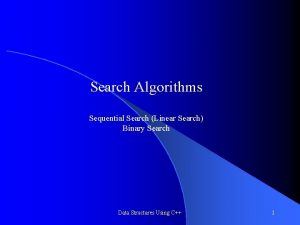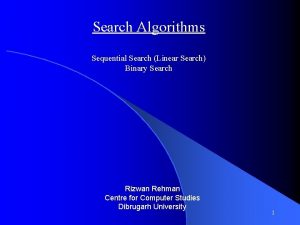Antihypernuclei production and search for Podd domain formation










































- Slides: 42

Anti-hypernuclei production and search for P-odd domain formation at RHIC Gang Wang (for the STAR Collaboration) UCLA A colored and flavored system in collision. . .

Outline Exotic particle Exotic phenomenon S Z N 2

What is a hypernucleus? A nucleus containing at least one hyperon in addition to nucleons. Hypernuclei of lowest A No one has ever observed any antihypernucleus before us (STAR). p + - (64%); n + 0 (36%) The first hypernucleus was discovered by Danysz and Pniewski in 1952 , formed in a cosmic ray interaction in a balloon-flown emulsion plate. M. Danysz and J. Pniewski, Phil. Mag. 44 (1953) 348 3

Why (anti-)hypernuclei? Hypernuclei: ideal lab for YN and YY interaction – Baryon-baryon interaction with strangeness sector – Input for theory describing the nature of neutron stars Coalescence mechanism for production: depends on overlapping wave functions of Y+N at final stage Anti-hypernuclei and hypernuclei ratios: sensitive to anti-matter and matter profiles in HIC Extension of the nuclear chart into anti-matter with S [1] W. Greiner, Int. J. Mod. Phys. E 5 (1995) 1 4

International Hyper-nuclear network PANDA at FAIR SPHERE at JINR • 2012~ • Anti-proton beam • Double -hypernuclei • -ray spectroscopy • Heavy ion beams • Single -hypernuclei Hyp. HI at GSI/FAIR MAMI C JLab • 2000~ • Electro-production • Single -hypernuclei • -wavefunction • 2007~ • Electro-production • Single -hypernuclei • -wavefunction BNL • Heavy ion beams • Anti-hypernuclei • Single -hypernuclei • Double -hypernuclei • Heavy ion beams • Single -hypernuclei at extreme isospins • Magnetic moments FINUDA at DA NE • e+e- collider • Stopped-K- reaction • Single -hypernuclei • -ray spectroscopy (2012~) J-PARC • 2009~ • Intense K- beam • Single and double -hypernuclei • -ray spectroscopy 5

Relativistic Heavy Ion Collider (RHIC) PHENIX RHIC STAR AGS TANDEMS Animation M. Lisa 6

Relativistic Heavy-ion Collisions initial stage QGP and hydrodynamic expansion pre-equilibrium hadronization and freeze-out u New state of matter: QGP RHIC creates hot and dense matter, containing equilibrium in phase space population of u, d and s: ideal source of hypernuclei about equal numbers of q and anti-q: ideal source of anti-nuclei RHIC white paper: Nucl. Phys. A 757 7

STAR Detector STAR consists of a complex set of various detectors, a wide range of measurements and a broad coverage of different physics topics. 8

Event display STAR TPC: an effectively 3 -D ionization camera with over 50 million pixels. 9

Data-set and track selection 3 H mesonic decay, m=2. 991 Ge. V/c 2, B. R. 0. 25 Secondary vertex finding technique l Data-set used, Au+Au 200 Ge. V ü~67 M year 2007 minimum-bias ü~22 M year 2004 minimum-bias ü~23 M year 2004 central, ü |VZ|<30 cm l Tracks level: standard STAR quality cuts, i. e. , not near edges of acceptance, good momentum & d. E/dx resolution. DCA of v 0 to PV < 1. 2 cm DCA of p to PV > 0. 8 cm DCA of p to 3 He < 1. 0 cm Decay length > 2. 4 cm QM 09 proceeding: ar. Xiv: 0907. 4147 10

3 He & anti-3 He selection Theory curve: Phys. Lett. B 667 (2008) 1 Select pure 3 He sample: 3 He: 5810 counts anti- 3 He: 2168 counts condition: -0. 2 < z < 0. 2 & dca < 1. 0 cm & p > 2 Ge. V/c … 11

signal from the data STAR Collaboration, Science 328 (2010) 58 Signal observed from the data (bin-by-bin counting): 157 ± 30 Mass: 2. 989 ± 0. 001 ± 0. 002 Ge. V; Width (fixed): 0. 0025 Ge. V. Projection on anti-hypertriton yield: =157*2168/5810= 59 ± 11 12

signal from the data STAR Collaboration, Science 328 (2010) 58 Projection on anti-hypertriton yield: 59 ± 11 Signal observed from the data (bin-by-bin counting): 70 ± 17 Mass: 2. 991 ± 0. 002 Ge. V; Width (fixed): 0. 0025 Ge. V. 13

Combined the signal STAR Collaboration, Science 328 (2010) 58 Combined hyper. T and anti-hyper. T signal : 225 ± 35 It provides a >6 s significance for discovery. 14

Measure the lifetime STAR Collaboration, Science 328 (2010) 58 ps We measure t = 267 ± 5 ps PDG value t = 263 ± 2 ps PDG: Phys. Lett. B 667 (2008) 1 15

Production rate Coalescence => 0. 45 ~ 0. 77*0. 77 Tabulated ratios favor coalescence 16

A case for energy scan STAR Collaboration, Science 328 (2010) 58 Phase diagram plot: ar. Xiv: 0906. 0630 RHIC is carrying out Beam Energy Scan as we speak. Baryon-strangeness correlation: PRL 95 (2005) 182301, PRC 74 (2006) 054901, PRD 73 (2006) 014004. Baryon-strangeness correlation via hypernuclei: a viable experimental signal to search for the onset of deconfinement. model calculation: S. Zhang et al, Phys. Lett. B 684, 224(2010) 17

Summary I has been observed for first time; 70 candidates, with significance ~4 s. Consistency check has been done on analysis; 157 candidates, with significance better than 5 s. The measured lifetime is ps, consistent with free lifetime (263 ps) within uncertainty. The 3 / ratio is measured as 0. 49 ± 0. 18 ± 0. 07, and He / 3 He is 0. 45 ± 0. 02 ± 0. 04, favoring coalescence. RHIC is the best anti-matter machine ever built! 18

Outlook Lifetime: – 10 times more data within this year Production rate: –baryon-strangeness correlation –a case for energy scan –establish a trend from AGS-SPS-RHIC-LHC 3 LH d+p+p channel measurement: d-identification via To. F. Search for other hypernucleus: 4 LH, 4 LHe, 4 LLH, 3 XH, AGS-E 906, Phys. Rev. Lett. 87, 132504 (2001) Search for anti-α 19

Parity violation Looking into a mirror, you see someone else… It’s a parity violation? ! Parity transformation: A spatial inversion of the coordinates. Origins of parity violation: Kharzeev, PLB 633 260 (2006) [hep-ph/0406125]; Kharzeev, Mc. Lerran, Warringa, NPA 803 227 (2008); Kharzeev, Zhitnitsky, NPA 797 67 (2007); Fukushima, Kharzeev, Waringa, PRD 78, 074033. 1. Global parity violation Occurs in weak interactions § Confirmed 2. Local parity violation Predicted in strong interactions § we are working on it… 20

Local P violation in strong interactions P/CP invariance are (globally) preserved in strong interactions: neutron EDM (electric dipole moment) experiments: Θ<10− 11 Pospelov, Ritz, PRL 83: 2526 (1999) Baker et al. , PRL 97: 131801 (2006) In heavy-ion collisions, the formation of (local) meta-stable P-odd domains is not forbidden. The strong magnetic field (B~1015 T) could induce electric field (E~θB), and manifest the P-odd domains with charge separation w. r. t Reac. plane. Kharzeev, PLB 633: 260 (2006) Kharzeev, Mc. Lerran, Warringa, NPA 803: 227 (2008) 21

Charge separation in strong interactions A direct measurement of the P-odd quantity “a” should yield zero. S. Voloshin, PRC 70 (2004) 057901 Non-flow/non-parity effects: largely cancel out Directed flow: vanishes if measured in a symmetric rapidity range P-even quantity: still sensitive to charge separation 22

Factorization S. Voloshin, PRC 70 (2004) 057901 If the event plane or the third particle has non-flow correlations with the first two particles, we can NOT safely factorize the above equation. 23

STAR ZDC-SMD • New knowledge of the direction of the impact parameter vector • Minimal, if any, non-flow/non-parity effects • Worse resolution than from TPC… can be overcome with statistics SMD is 8 horizontal slats & 7 vertical slats located at 1/3 of the depth of the ZDC side view Transverse plane of ZDC Scintillator slats of Shower Max Detector 24

Approach With the EP from ZDC, the 3 -particle non-flow/non-parity correlations (independent of the reaction plane) will be basically eliminated as a source of background. As a systematic check, I also calculate directly The results on the following slides are based on Au+Au collisions at 200 Ge. V, taken in RHIC run 2007, except otherwise specified. 25

Results with different event planes STAR Preliminary Lost in the medium? The correlator using ZDC event plane is consistent with that using TPC event plane. 26

Different charge combinations STAR Preliminary The + + and – – combinations are consistent with each other. 27

Dilution effect In the quark-gluon medium, there could be multiple P-odd domains. The net effect is like a random walk, but one-dimensional. What do we know about the position Rn after n steps? Rn follows a Gaussian distribution: mean = 0, and rms = Our measurement of PV is like Rn 2, expected to be n. Compared with going in one fixed direction, where Rn 2 = n 2, the "random-walk" measurement is diluted by a factor ~ n ~ Nch. 28

Dilution effect Non-zero Radial flow? Weaker B field STAR Preliminary Thin medium The factor Npart is used to compensate for dilution effect. 29

Systematic check: v 1{ZDC-SMD} S. Voloshin, PRC 70 (2004) 057901 STAR Preliminary If v 1 (η) is not antisymmetric around η= 0, then this term won’t vanish. v 1 (η) crosses zero for both charges in the TPC region. 30

Systematic check: a 1{ZDC-SMD} S. Voloshin, PRC 70 (2004) 057901 STAR Preliminary The average magnitude of <a 1> is ~ 10 -4. Its corresponding contribution to the correlator, <a 1>, will be safely negligible. 31

Systematic check: η gap STAR Preliminary The same-sign correlation approaches zero when the η gap increases. 32

Systematic check: p. T gap STAR Preliminary The non-zero same-sign correlator for p. T gap > 200 Me. V/c indicates that we are safe from HBT or Coulomb effects. 33

More checks from TPC EP STAR Collaboration, ar. Xiv: 0909. 1717 We have looked at lower beam energy (62 Ge. V) and/or smaller system (Cu+Cu), to see qualitatively similar results. 34

Summary II The formation of (local) meta-stable P-odd domains in heavy-ion collisions is predicted to lead to charge separation w. r. t the reaction plane. P-even correlator has been measured with event planes from both STAR TPC and ZDC; and the results are consistent! The gross feature of the correlator meets the expectation for the picture of local Parity Violation: charge separation, suppression of OS by opacity, weaker OS signal in central collisions, OS&LS symmetry in peripheral collisions. . . STAR has checked the possible effects on v 1, a 1, η gap, and p. T gap. 35

Interpretations Interpretation 1: Interpretation 2: Out-of-Plane Charge Separation Flowing “structures” + + X ΨRP - - Implies Local P-violation of strong interactions X X ΨRP X X = unknown structure Does Not Imply P violation of the strong interactions 36

Interpretation 2 Scenario 1: Scenario 2: charge conservation/cluster + v 2 charge conservation/cluster + v 1 symmetry fluctuation + - ΨRP + - + - ΨRP Need some investigation STAR Collaboration, PRL 103 (2009)251601 37

Alternative measurements These observables contain all possible (mixed) harmonic terms, while the correlator observables previously shown contain only one. Charge asymmetry correlation 38

Alternative measurements Oppo-sign: STAR preliminary - aligned (‹A+A-› > 0) - local charge conservation? - ‹A+A-›UD > ‹A+A-›LR - contradicts LPV expectation? - not dominantly RP-related Same-sign: d+Au No real reaction plane here! - δ‹A 2›UD > δ‹A 2›LR - meets LPV expectation - δ‹A 2› < 0 in central collisions Different observables have different sensitivities to the charge separation, and suffer different backgrounds. 39

Outlook With zero net charge, the neutral particles are expected to be much less affected by the electric field. Λ, Ks 0 et al. Deformed nuclei can provide the collisions with zero magnetic field and large v 2 to test theory. body-body U+U collisions Isobaric couple of spherical nuclei : different magnetic fields: Neodymium(144, 60)Samarium(144, 62) et al. Beam energy below QGP threshold Beam Energy Scan CP-violating decays η→π+π- et al. R. Millo and E. V. Shuryak, ar. Xiv: 0912. 4894 40

Back-up 41

Systematic check: EP resolution 42
 Formation podd
Formation podd Daniel podd
Daniel podd Alur post
Alur post Codomain vs range
Codomain vs range Frequency domain to time domain
Frequency domain to time domain Compiler bridges the semantic gap between which domains?
Compiler bridges the semantic gap between which domains? Formation initiale vs formation continue
Formation initiale vs formation continue Z domain to frequency domain
Z domain to frequency domain Z domain to frequency domain
Z domain to frequency domain Z transform integrator
Z transform integrator Domain specific vs domain general
Domain specific vs domain general Domain specific software engineering
Domain specific software engineering Problem domain vs knowledge domain
Problem domain vs knowledge domain S domain to z domain
S domain to z domain Informed search and uninformed search in ai
Informed search and uninformed search in ai Domain bias in web search
Domain bias in web search Fspos
Fspos Novell typiska drag
Novell typiska drag Tack för att ni lyssnade bild
Tack för att ni lyssnade bild Vad står k.r.å.k.a.n för
Vad står k.r.å.k.a.n för Shingelfrisyren
Shingelfrisyren En lathund för arbete med kontinuitetshantering
En lathund för arbete med kontinuitetshantering Adressändring ideell förening
Adressändring ideell förening Tidbok yrkesförare
Tidbok yrkesförare Anatomi organ reproduksi
Anatomi organ reproduksi Vad är densitet
Vad är densitet Datorkunskap för nybörjare
Datorkunskap för nybörjare Stig kerman
Stig kerman Debattinlägg mall
Debattinlägg mall Delegerande ledarstil
Delegerande ledarstil Nyckelkompetenser för livslångt lärande
Nyckelkompetenser för livslångt lärande Påbyggnader för flakfordon
Påbyggnader för flakfordon Kraft per area
Kraft per area Svenskt ramverk för digital samverkan
Svenskt ramverk för digital samverkan Kyssande vind
Kyssande vind Presentera för publik crossboss
Presentera för publik crossboss Vad är ett minoritetsspråk
Vad är ett minoritetsspråk Plats för toran ark
Plats för toran ark Treserva lathund
Treserva lathund Luftstrupen för medicinare
Luftstrupen för medicinare Claes martinsson
Claes martinsson Cks
Cks Byggprocessen steg för steg
Byggprocessen steg för steg
